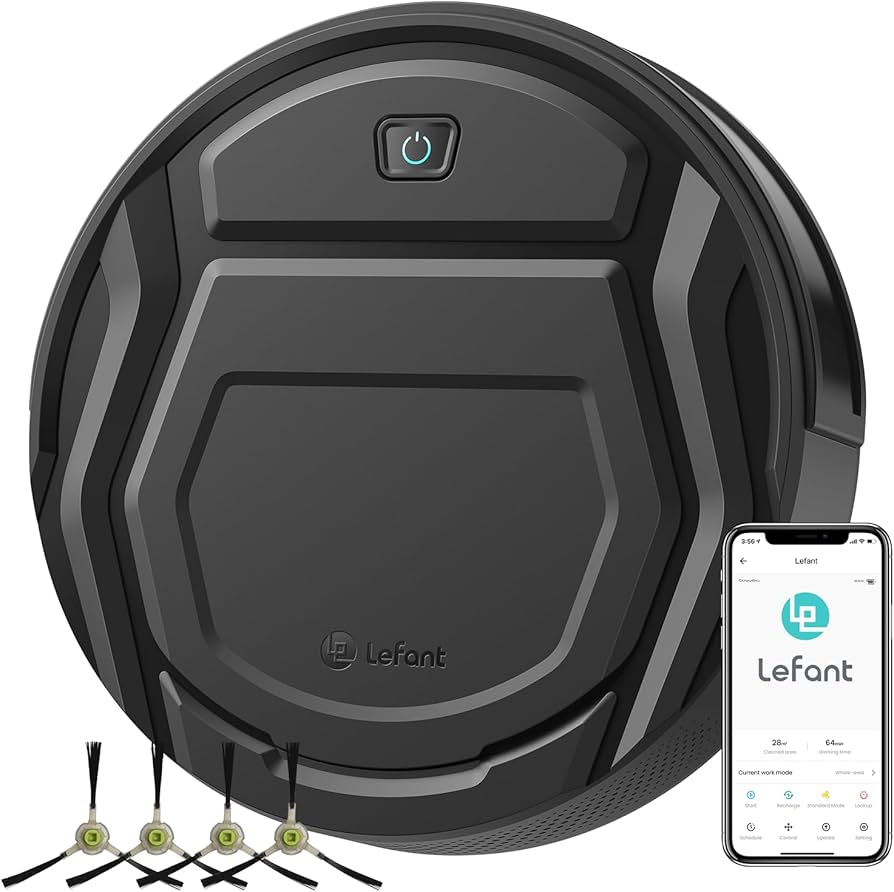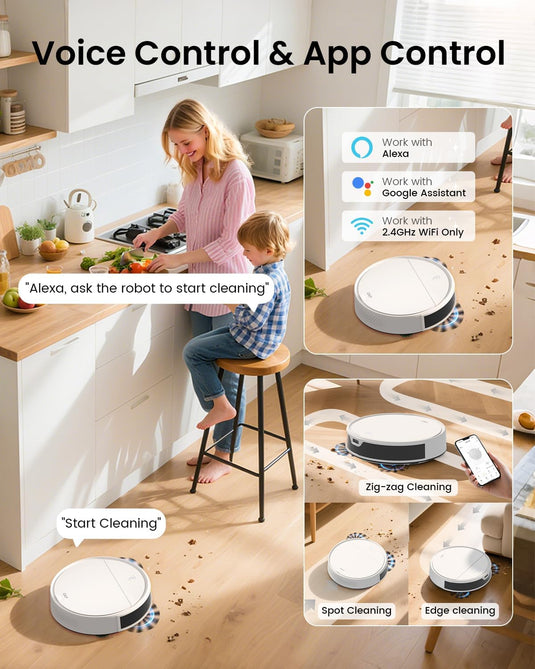Imagine coming home to spotless floors without lifting a finger. Sounds like a dream, right?
With a voice-controlled robot vacuum, this dream can become your everyday reality. But how exactly does this smart gadget understand your commands and clean your home so efficiently? If you’ve ever wondered how these little machines work their magic just by listening to you, you’re in the right place.
Keep reading to uncover the simple secrets behind your voice-controlled robot vacuum and discover how it can make your life easier starting today.
Voice-control Technology
Voice-control technology makes robot vacuums easy to use. It lets you start, stop, or direct cleaning using your voice. This hands-free method saves time and effort. You just speak, and the vacuum listens and acts. The technology combines several smart features to understand and respond to your commands.
Speech Recognition Basics
Speech recognition converts your spoken words into digital signals. The vacuum’s microphone picks up your voice clearly. Then, software analyzes sounds to find commands. It matches sounds to known words and phrases. The system works best in quiet rooms. Clear speech helps the vacuum understand you faster.
Integration With Smart Assistants
Many robot vacuums connect to smart assistants like Alexa or Google Assistant. These assistants act as a bridge between you and the vacuum. You talk to the assistant, which sends commands to the vacuum. This allows control from anywhere in your home. Voice control becomes part of your smart home setup.
Command Processing
Once the vacuum receives a command, it processes the request. It checks what action you want, such as start or stop cleaning. The vacuum then plans the best way to perform the task. It avoids obstacles and cleans efficiently. Feedback like lights or sounds confirms the command was accepted.

Robot Vacuum Components
Robot vacuum cleaners have several key parts that help them clean your floors efficiently. These parts work together to navigate your home, pick up dirt, and store it. Understanding these components shows how smart and useful these devices are.
Sensors And Navigation
Sensors help the robot see and avoid obstacles. They detect walls, furniture, and stairs. Some robots use laser or camera sensors for precise mapping. This allows the vacuum to plan its cleaning path. Sensors prevent the robot from bumping or falling.
Motors And Brushes
Motors power the wheels and brushes. Wheels move the robot across different floors. Brushes sweep dust and debris into the vacuum’s path. Main brushes work on carpets and hard floors. Side brushes clean edges and corners.
Dust Collection System
The dust collection system stores all the dirt the robot picks up. It usually has a dustbin inside the vacuum. Filters trap fine dust and allergens. Some models have bags, while others use containers. This system keeps your home cleaner and air fresher.
How Voice Commands Operate
Voice-controlled robot vacuums use voice commands to make cleaning simple. They listen, understand, and act on your spoken instructions. This process involves several steps to ensure the vacuum works just as you say.
Activation And Listening Mode
The vacuum stays quiet until it hears a wake word. This word activates its listening mode. Once active, the device listens carefully for your command. It uses built-in microphones to catch your voice clearly. This step saves battery and avoids accidental actions.
Interpreting Instructions
The vacuum’s software processes the voice command. It breaks down the words to find meaning. Simple commands like “start cleaning” or “stop” are easy to understand. More complex instructions like “clean the kitchen” require mapping and area recognition. The vacuum uses smart algorithms to decode your intent accurately.
Executing Cleaning Tasks
After understanding, the robot vacuum begins the task. It moves to the specified area or starts full cleaning. Sensors help avoid obstacles and stairs during cleaning. The vacuum adjusts suction and speed based on floor type. It follows your command until the job is done or you say stop.
Connectivity And Setup
Setting up a voice-controlled robot vacuum starts with connecting it to your home network. This connection allows you to control the vacuum remotely and use voice commands. The setup process is simple and quick, designed for users of all skill levels.
Wi-fi And Bluetooth Roles
Wi-Fi connects the robot vacuum to the internet and your smartphone. It enables remote control from anywhere. Bluetooth links the vacuum to your phone during initial setup. Bluetooth also helps with quick local commands without internet.
App Integration
Most robot vacuums work with a dedicated app. The app shows cleaning schedules, battery status, and maps. It also lets you start or stop cleaning with a tap. Voice assistants like Alexa or Google Home connect through the app for easy control.
Initial Configuration Steps
First, download the vacuum’s app on your phone. Turn on the vacuum and enable Bluetooth. Follow the app instructions to link the vacuum to Wi-Fi. Once connected, test voice commands to ensure proper setup.
Common Features And Modes
Voice-controlled robot vacuums offer several smart features and cleaning modes. These make cleaning easier and more efficient. Understanding these common features helps you get the best use from your device.
Spot Cleaning
Spot cleaning targets a small, specific area. The robot moves in tight circles over the dirty spot. This mode works well for spills or concentrated dirt patches. You can activate spot cleaning using voice commands. It saves time by focusing on problem areas.
Scheduled Cleaning
Scheduled cleaning lets you set cleaning times in advance. The robot starts cleaning automatically at the chosen time. This feature keeps your floors clean regularly without manual effort. Voice control makes it easy to adjust schedules quickly. It fits well with busy daily routines.
Obstacle Avoidance
Obstacle avoidance helps the robot navigate around furniture and objects. Sensors detect walls, chairs, and other obstacles. The vacuum changes direction to avoid collisions and falls. This mode protects both your furniture and the robot. It ensures smooth, efficient cleaning paths.

Troubleshooting Voice Commands
Troubleshooting voice commands on your robot vacuum can improve its performance. Voice control should be simple and smooth. Sometimes, the vacuum may not understand your commands. This can cause frustration and slow down cleaning. Knowing how to fix common issues helps keep the vacuum working well.
Recognizing Command Errors
Sometimes, the vacuum misunderstands what you say. It might miss words or hear wrong ones. Background noise can cause errors. Speak clearly and slowly for better results. Check if the command matches the list of supported instructions. Wrong phrases often lead to no action.
Improving Voice Recognition
Place the vacuum closer when speaking. Avoid loud rooms or music nearby. Use simple commands with few words. Train the device by repeating commands if it allows. Keep the microphone clean and free from dust. These steps help the vacuum hear you better.
Resetting The Device
Resetting can fix many voice control problems. Turn off the vacuum and unplug it. Wait about 30 seconds before turning it back on. Some models have a reset button to press. Check the manual for exact instructions. A reset clears minor bugs and refreshes the system.
Future Innovations
The future of voice-controlled robot vacuums looks very promising. These machines will become smarter, easier to use, and more connected to other devices in your home. Innovations in technology will improve cleaning performance and make daily life simpler.
Ai Enhancements
Artificial intelligence will help robot vacuums learn your home’s layout better. They will recognize objects and avoid obstacles more quickly. AI will also allow vacuums to adjust cleaning based on floor type or dirt level. This makes cleaning more efficient and thorough.
Improved Voice Interaction
Voice commands will become clearer and more natural. Robots will understand different accents and speech speeds. They will also follow complex instructions, like cleaning specific rooms or avoiding certain areas. This makes controlling the vacuum easier and more flexible.
Expanded Smart Home Integration
Robot vacuums will work smoothly with other smart devices. They will connect with home security systems, lights, and thermostats. This allows for automated routines, such as cleaning when you leave the house. Integration will create a more connected and convenient home.

Frequently Asked Questions
How Does A Voice-controlled Robot Vacuum Connect?
Voice-controlled robot vacuums connect via Wi-Fi or Bluetooth. This allows seamless communication with smart speakers or mobile apps for commands.
What Sensors Do Voice-controlled Robot Vacuums Use?
They use infrared, laser, or camera sensors to detect obstacles, map rooms, and avoid falls. This ensures efficient cleaning paths.
Can Voice Commands Schedule Cleaning Times?
Yes, voice commands can schedule cleaning sessions. You can set specific days and times for automatic vacuuming through your smart assistant.
Are Voice-controlled Robot Vacuums Compatible With All Smart Assistants?
Most support popular assistants like Alexa, Google Assistant, and Siri. Compatibility varies, so check your vacuum’s specifications before purchase.
Conclusion
Voice-controlled robot vacuums make cleaning easier and faster. They listen to your commands and clean the rooms you choose. Sensors help them avoid obstacles and cover every corner. You save time and effort by using simple voice instructions. These devices blend technology with convenience for your home.
Understanding how they work helps you use them better. Smart cleaning is now a part of everyday life. Small devices, big help.



